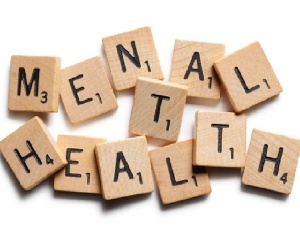Not too long ago I happened to be a guest at a public lecture on Mental Health at the auditorium of the Takoradi Technical University under the auspices of Ghana Mental Health Authority.
The lecture, under the theme “Mental Health at Workplace” was part of activities lined up to commemorate this year’s mental health week here in the Western Region sought to create the awareness of the populace on issues of mental health.
I was so happy to have been part of the lecture because as an Industrial Relations practitioner, issues of mental health at the workplace are fundamental to my passion and profession. It should be noted that mental health problems are common and it’s likely you would know someone who has experienced them.
In fact World Health Organisation estimates 1 in 4 people will experience a mental health problem in their lifetime. Indeed mental health is a complex issue and it’s easy to become confused and unclear about its impact. What is for sure is that everyone's mental health is important hence the need for it to be taken very serious.
Interestingly the misconceptions around mental health problems are fed by stereotypes associated with violence, criminality and danger which are equally endorsed by the media. The truth is that most people who are mentally ill are not violent.
They are more likely to be a victim of violence and also more likely to harm themselves than harm others. What is so often misunderstood about mental health problems is that they don’t define a person or their potential in life. Recovery is possible with the right support and people can and do go on to lead rewarding and fulfilling lives.
In this article I will want to discuss mental health at the workplace and the need to promoting mental health at the workplace. Research has shown that 60-70% of people with common mental disorders are in work (Chief Medical Officer’s Annual Report, Dame Sally Davies, 2014). The chances are you probably work with someone with a mental health problem.
Mental Health and Mental Illness
Many a time people confuse the difference between mental health and mental illness. Although the terms are often used interchangeably, mental health and mental illness is not the same thing; but they are also not mutually exclusive.
A fundamental difference between mental health and mental illness is that everyone has some level of mental health all of the time, just like physical health, whereas it is possible to be without mental illness.
Mental health is therefore is a state of well-being in which the individual realizes his or her own abilities, can cope with the normal stresses of life, can work productively and fruitfully and is able to make a contribution to his or her community.
Whereas, Mental illness is said to mean a recognized, medically diagnosable illness that results in the significant impairment of an individual’s cognitive, affective or relational abilities. Mental disorders result from biological, developmental and/or psychosocial factors and can be managed using approaches comparable to those applied to physical disease (i.e., prevention, diagnosis, treatment and rehabilitation).
Ultimately, this means that someone can be mentally healthy with a mental illness and that someone can have poor mental health without a mental illness.
At the workplace
It can be a little disheartening to consider that over a lifetime, up to 80,000 hours will be spent at work. Because work plays such a significant role in our lives, it’s important to recognize its impact on mental health and wellbeing. If your workplace isn’t your ‘happy place’, that’s a big chunk of life desperately waiting for 5pm – and Fridays – to roll around. And it’s a scenario that’s likely to make you feel trapped and miserable way beyond Monday morning.
The impact of mental health problems in the workplace has serious consequences not only on the individual but also for the productivity of the enterprise. Employee performances, rates of illness, absenteeism, accidents and staff turnover are all affected by employees' mental health status.
Globally, more than 300 million people suffer from depression, the leading cause of disability, with many of these people also suffering from symptoms of anxiety. A recent WHO-led study estimates that depression and anxiety disorders cost the global economy US$ 1 trillion each year in lost productivity.
Unemployment is a well-recognized risk factor for mental health problems, while returning to, or getting work is protective. A negative working environment may lead to physical and mental health problems, harmful use of substances or alcohol, absenteeism and lost productivity
Despite poor mental health not defined as an illness, having poor mental health is associated with emotional distress and psychosocial impairment comparable to that of a major depressive episode.
The effects of poor mental health are both severe and prevalent, with poor mental health being more common than depression. Learning more about mental health and mental illness is a crucial step in dispelling stigma, stopping prejudice and promoting early identification and effective treatment.
The three most significant determinants of mental health are social inclusion, freedom from discrimination and violence and access to economic resources. These factors are inextricably intertwined with employment. As workplaces develop mental health promotion programs, these determinants must be addressed in the programming.
Work-related risk factors for health
There are many risk factors for mental health that may be present in the working environment. Most risks relate to interactions between type of work, the organizational and managerial environment, the skills and competencies of employees, and the support available for employees to carry out their work.
For example, a person may have the skills to complete tasks, but they may have too few resources to do what is required, or there may be unsupportive managerial or organizational practices.
Risks to mental health include inadequate health and safety policies, poor communication and management practices, limited participation in decision-making or low control over one’s area of work, low levels of support for employees, inflexible working hours, and unclear tasks or organizational objectives.
Risks may also be related to job content, such as unsuitable tasks for the person’s competencies or a high and unrelenting workload. Some jobs may carry a higher personal risk than others which can have an impact on mental health and be a cause of symptoms of mental disorders, or lead to harmful use of alcohol or psychoactive drugs. Risk may be increased in situations where there is a lack of team cohesion or social support.
Bullying and psychological harassment (also known as “mobbing”) are commonly reported causes of work-related stress by workers and present risks to the health of workers. They are associated with both psychological and physical problems. These health consequences can have cost employers in terms of reduced productivity and increased staff turnover. They can also have a negative impact on family and social interactions.
Mental health is not static
It is important to remember that mental health and mental illness are not static; they change over time depending on many factors. Some of the factors that influence mental health include: levels of personal and workplace stress; lifestyle and health behaviours; exposure to trauma; and genetics.
When the demands placed on any individual exceed their resources and coping abilities, their mental health will be negatively affected.
Two examples of common demands that have the ability to wear away at people are: i) working long hours under difficult circumstances, and ii) caring for a chronically ill relative. Economic hardship, unemployment, underemployment and poverty also have the potential to undermine mental health. In fact, with my background and experience and without gross exaggeration I can say that scores of Ghana’s work environments particularly within public sectors are not psychologically safe or healthy.
Types of mental illnesses
There are many different types of mental illnesses, just as there are many types of physical illness. Some of the defining characteristics of a mental illness are that it is a recognized, medically diagnosable illness; that it can cause significant cognitive, affective, or relational impairment; that it results from biological, developmental and/or psychosocial factors, and that it can be managed using physical disease approaches (i.e. prevention, diagnosis, treatment and rehabilitation).
Research on mental illness is evolving. As time passes, more mental illnesses are being discovered and diagnosed. Some of the more common and well researched mental illnesses, by category of illness, include, Mood disorders (affective disorders): Depression, mania and bipolar; Anxiety disorders: Generalized anxiety disorder, post-traumatic stress disorder, obsessive-compulsive disorder, panic disorder; Psychotic disorders: schizophrenia; Concurrent disorders: addictions and substance abuse, and Personality disorders: antisocial personality disorder, obsessive-compulsive personality disorder
If you are concerned that you or someone you know may have an undiagnosed mental illness, encourage them to visit a doctor or health professional or go to www.mhaghana.org
Mental illness is much like diabetes, heart disease and a broken leg — one can live with it and recover from it. Recovery is not an end state; it does not mean that the individual no longer has depression, schizophrenia or another mental illness. Recovery means that the person has stabilized and regained their role in society.
Creating a healthy workplace
An important element of achieving a healthy workplace is for the tripartite namely labour, employers and government to deliberately devise legislation, strategies and polices as has been adopted by other countries in this area. A healthy workplace can be described as one where workers and managers actively contribute to the working environment by promoting and protecting the health, safety and well-being of all employees.
A recent guide from the World Economic Forum suggests that interventions should take a 3-pronged approach namely Protect mental health by reducing work–related risk factors, Promote mental health by developing the positive aspects of work and the strengths of employees and Addressing mental health problems regardless of cause.
The guide highlights steps organizations can take to create a healthy workplace, including: Awareness of the workplace environment and how it can be adapted to promote better mental health for different employees, learning from the motivations of organizational leaders and employees who have taken action, not reinventing wheels by being aware of what other companies who have taken action have done, understanding the opportunities and needs of individual employees, in helping to develop better policies for workplace mental health, and awareness of sources of support and where people can find help.
Interventions and good practices that protect and promote mental health in the workplace include but not limited to, the implementation and enforcement of health and safety policies and practices; including identification of distress, harmful use of psychoactive substances and illness and providing resources to manage them; informing staff that support is available; involving employees in decision-making, conveying a feeling of control and participation; organizational practices that support a healthy work-life balance; programmes for career development of employees, and recognizing and rewarding the contribution of employees.
Mental health interventions should be delivered as part of an integrated health and well-being strategy that covers prevention, early identification, support and rehabilitation.
Occupational health services or professionals may support organizations in implementing these interventions where they are available, but even when they are not, a number of changes can be made that may protect and promote mental health. Key to success is involving stakeholders and staff at all levels when providing protection, promotion and support interventions and when monitoring their effectiveness.
Available cost-benefit research on strategies to address mental health points towards net benefits. For example, a recent WHO-led study estimated that for every USD $1 put into scaled up treatment for common mental disorders, there is a return of USD $4 in improved health and productivity.
Supporting people with mental disorders at work
Organizations have a responsibility to support individuals with mental disorders in either continuing or returning to work. Research shows that unemployment, particularly long term unemployment, can have a detrimental impact on mental health. Many of the initiatives outlined above may help individuals with mental disorders. In particular, flexible hours, job-redesign, addressing negative workplace dynamics, and supportive and confidential communication with management can help people with mental disorders continue to or return to work.
Access to evidence-based treatments has been shown to be beneficial for depression and other mental disorders. Because of the stigma associated with mental disorders, employers need to ensure that individuals feel supported and able to ask for support in continuing with or returning to work and are provided with the necessary resources to do their job.
Article 27 of The UN Convention on the Rights of Persons with Disabilities (CRPD) provides a legally-binding global framework for promoting the rights of people with disabilities (including psychosocial disabilities). It recognizes that every person with a disability has the right to work, should be treated equally and not be discriminated against, and should be provided with support in the workplace.
Trade Union should ensure that issues of mental health are taken in high esteem and there are some clear ways to bargain for equality. Trade Unions c continues to campaign in the workplace as well raise awareness about the issues facing people with mental health problems.
Provide information on practical solutions and examples of good practice.
Use this to increase people’s understanding of mental health in the workplace. This will go some way in dispelling myths and fears about people with mental health problems. It may also help to encourage people with mental health problems to talk about their experiences and become active in the workplace.
Trade Unions should collaborate with employers to organize workplace forums for members with mental health problems. Engage participants by talking to members formally and informally about their issues and ideas for resolving these and organize union led training on issues members have identified.
Trade Unions specifically may also wish to engage with wider campaign groups to develop workplace campaigns.
Organising around mental health need not be arduous. It requires significant work to smash the stigma that still sadly reigns. Unions will always be stronger than an individual in doing this as they represent the collective voice.
Using this voice to make it easier for people with mental health problems to work with dignity remains an important part of the bargaining agenda.
Opinions of Tuesday, 31 October 2017
Columnist: Jerry Detse Mensah-Pah



















